Reconnaissance and Surveillance Leader’s Course
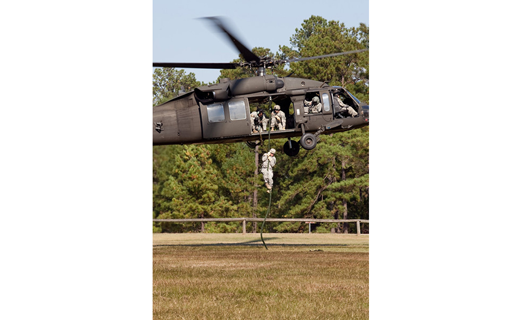
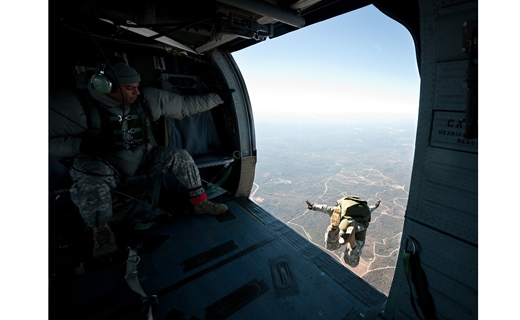
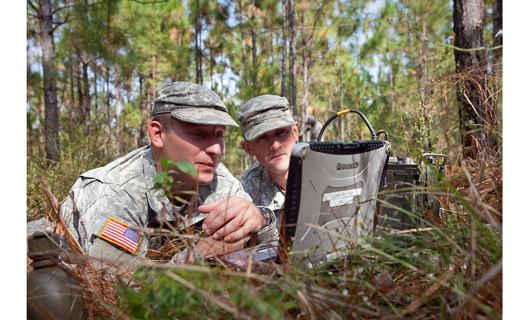
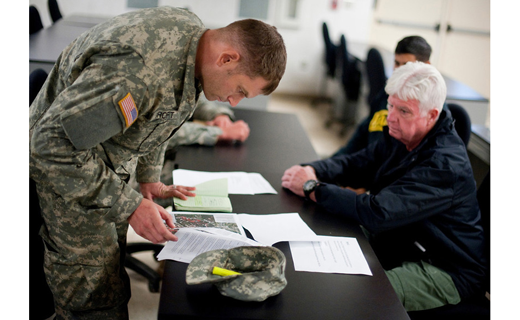
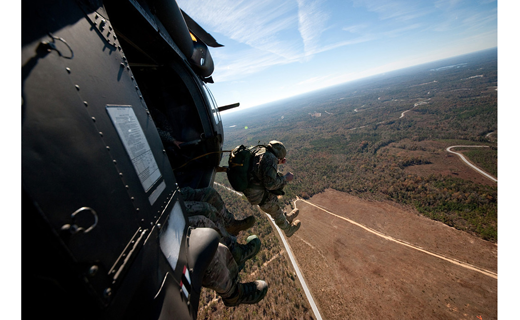
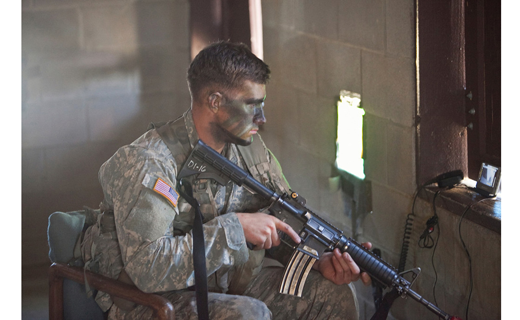
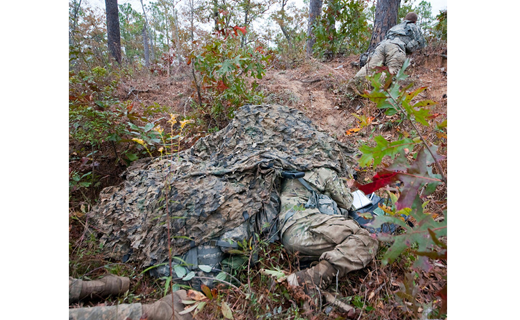
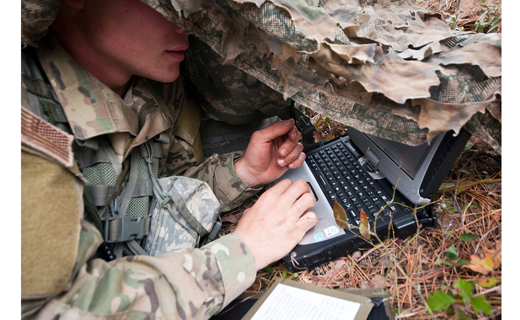
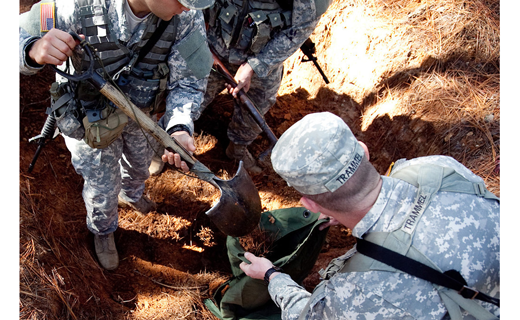
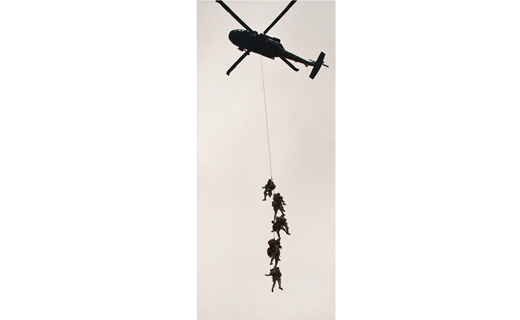
For some Soldiers, it’s “shoot, move and communicate,” but for Soldiers skilled in the art of reconnaissance and surveillance, it’s “communicate, collect and report.” Sometimes this task occurs without heavy fire support only several dozen feet from the enemy and possibly thousands of miles from friendly forces.
The question is: Where do you send Soldiers and leaders to teach them the kind of control, intuition and skill it takes to deal with this kind of situation? The answer is to the Maneuver Center of Excellence’s 29-day-long Reconnaissance and Surveillance Leader’s Course (RSLC).
Department of Reconnaissance
This specialized course, a long-standing sister course to Ranger School, was recently integrated into the Armor School to form the new Department of Reconnaissance. RSLC serves as just a piece of the reconnaissance and security (R&S) training this newly formed consolidation offers; in conjunction with the Army Reconnaissance Course and Cavalry Leader’s Course, RSLC provides a particular level of learning for all military occupational specialties (MOSs) associated with reconnaissance.
“We’ve reorganized here at the Maneuver Center and we’ve brought the [R&S] classes together,” said BG Leopoldo Quintas, Armor School commandant. “What we’re endeavoring to do is establish a continuity of training from inception, when a Soldier enters the Army, all through the enlisted ranks and officer ranks to make sure we develop experts in reconnaissance and security.”
As Soldiers travel through the ranks in the U.S. Army, they are educated in their professional development in the Noncommissioned Officer Academy. However, throughout their career, depending on their MOS, they need to continue to develop their individual skills and MOS-related skills.
“RSLC trains young Soldiers and leaders about what reconnaissance is, how it fits into the commander’s planning and actions on the ground, and how it will usually lead to successful mission accomplishment,” explained COL Robert Choppa, Infantry School commandant.
Consolidating all the reconnaissance courses into one brigade gives service members who attend RSLC a one-stop shop for all their R&S needs.
“It is the only course in the Army where [a student] can learn about the specific reconnaissance tasks a small element is going to be required to do,” said LTC James Hayes, commander of 3rd Squadron, 16th Cavalry Regiment.
“It’s also the only place you can learn special insertion and extraction techniques, it’s the only place where you’re going to learn to plan for an air insertion, and it’s also the only course that’s teaching certain special skills.”
Gaining expertise in basics
To climb the reconnaissance ranks, you must first be an expert in the basics, according to 1SG Brian Baumgartner. “No matter your MOS, these are the basics; usually the best people in the world are the best at the basics,” said Baumgartner, the course’s first sergeant and a former course writer and senior instructor. “We teach the basics very well. We teach a lot of special-mission tactics, too, but we teach the basics of doing a reconnaissance patrol very well.”
RSLC starts the same way most courses do: with an Army Physical Fitness Test (APFT). The course requires a student to patrol on foot for miles and carry a 75-pound rucksack for most of that distance. This requires endurance and strength, which are tested during the Army’s APFT. RSLC also requires a written land-navigation test, which is available on-line and should be taken, or attempted, before coming to the course because land navigation has the highest attrition rate of any of RSLC’s other standards.
“We do that because, as a reconnaissance Soldier, you need to know where you’re going,” Baumgartner said. “You can’t rely on Global Positioning System because it can be broken. You need to know how to look at a map and understand terrain and how to get there.”
Advanced land navigation, extraction methods
The five-point land-navigation course RSLC teaches has been compared to some of Special Operations’ courses and is considered advanced land navigation. Phase I of RSLC is mostly comprised of Skill Level I and II tasks, where students not only learn more skills, they also master the basics of woodland reconnaissance, small-unit tactics, patrolling and communications systems. The course’s cadre builds on skills students (hopefully) bring to the course and trains them to enhance those skills.
“In the first phase, we build them up, and if you didn’t have the skills when you got here, you’re going to have them by the time you hit Phase II so you can hit the ground running,” Baumgartner said. “When your boots hit the ground in Phase II, you should know what you have to do.”
Phase I teaches students the skills they need during their situational and final field-training exercises. These basic skills are how to build observation posts and hide sites, as well as special tactics and extraction methods. Other skills trained and tested include the student’s airborne abilities with not only static-line jumps from a UH-60 Blackhawk helicopter but also practice techniques mostly reserved for Special Operations units – like the high-altitude, high-open (HAHO) or high-altitude, low-open (HALO) military freefall (MFF) insertion methods. A HALO or HAHO jump, usually executed at around 25,000 feet with oxygen masks, is accomplished on Fort Benning, GA, at around 10,000 feet.
“RSLC conducts [MFF] operations to stay current because there are units out there that do jump MFF that are reconnaissance units, and sometimes these units come through our course,” Baumgartner said. “In the past, RSLC has been asked if a Special Forces or Special Operations unit came to the course, if it would be possible to jump HALO.”
In addition to airborne jumps, the students also learn extraction methods and other insertion methods like the Special Purpose Insertion / Extraction System (SPIES) and the Fast Rope Insertion / Extraction System (FRIES).
It’s important these reconnaissance Soldiers are given experience using these methods, not only because RSLC is one of the few courses that includes these methods in its program of instruction (PoI), but it’s also important students are able to see what exactly is done during the execution of these methods so they may include them in any plans they make in the next part of the course or in the future.
Communications
“It’s about showing students different options so they can plan their mission best for success,” Baumgartner said. “One of the most important skills the students learn in Phase I is communications. RSLC is one of the only military courses left to teach certain types of communications methods.”
SSG Chris Loken, an RSLC instructor, elaborated: “We teach three systems. We teach the [AN/PRC-148 Multiband Inter/Intra Team Radio (MBITR)]. That’s a squad-level radio you use to talk within your team. We also teach the [AN/PRC-117F Multiband Manpack Radio or Multiband Multi-mission Radio (MBMMR)], which has satellite capabilities, but we don’t apply it in the course. We like them to know about it because in theater, everybody’s using satellites. So we teach that here so they know how to use it when they get to theater. The [AN/PRC-150(C) Multiband Radio, also known as the Falcon II] is high-frequency (HF) communications, and it covers the HF band that’s the lowest band of frequencies we use. Because it uses such a low band, it doesn’t use satellites. It actually uses the ionosphere to get that signal from Point A to Point B.”
Learning all these communications methods allows a Soldier to use them and plan those capabilities into their mission.
“You have to talk,” Loken said. “If you can’t talk, you can’t report, and if you can’t report, that maneuver commander you’re supporting goes in blind.”
Another aspect of communications RSLC teaches is the transfer of images, video and other media to the commander. Radio communication was once the only way to relay information, and the Soldier would have to describe what he saw. While that form of communication is still widely used, it’s no longer the only capability at a Soldier’s disposal.
“Now we can send commanders pictures, videos and graphic representations of the ground, of what the [named area of interest (NAI)] looks like,” Baumgartner said. “If it’s an assault commander coming through, he can understand what the NAI looks like so he’s better prepared for that task.”
Evasion, recovery, survival
As the course continues, students move into more complex and higher skill-level tasks. One of the most important tasks a reconnaissance Soldier can maintain is the ability to survive. When his unit is dropped hundreds of miles inside enemy lines to observe an NAI and it is compromised, Soldiers need to know how to evade the enemy and survive until they can be recovered. Therefore RSLC teaches a class on evasion and recovery.
“At one point or another, if you’re deployed, there’s always a chance you’re going to need to know how to evade and how to be recovered, so I think it’s very important everybody knows this,” said SSG Charles Hannan, an RSLC instructor. “What’s important in this course is getting the guys to start thinking about coming up with a really good evasion plan.”
Part of RSLC is creating an evasion plan of action. This includes recognizing markings, calling aircraft and recognizing the environment they are in and where they can attain vital resources like water, edible plants and appropriate shelter.
“Along with evasion and recovery, we go pretty in-depth on the basics of survival, which is a huge part of being able to evade,” Hannan said. “Because even if you have a good plan to be recovered, if something goes wrong, you don’t necessarily know when you’re going to get recovered. It could be anywhere from 24 hours to 72 hours. You may have all your food and supplies, or you may not. So along with evasion and recovery, we teach the survival portion as well.”
These basics include things like how to make a fire, how to purify or procure water or food, and how to create a shelter. This part of the course teaches some of the basic survival, evasion and recovery techniques the Survival, Evasion, Resistance and Escape (SERE) Course teaches but on a more basic level. The point of the evasion and recovery class in RSLC is really to give the students the basics and start them thinking about how they will incorporate those basics into their plan.
“You need to survive long enough to be recovered,” Hannan iterated.
All Soldiers carry weapons, so you may be wondering why these Soldiers wouldn’t just engage any enemy they encounter. That is not part of the mission for most reconnaissance Soldiers; they may not have the proper resources, so evasion becomes their best option.
“If you’re a regular infantry squad, more than likely, you have a lot of firepower and you’re not far away from friendly lines,” Hannan said. “But long-range surveillance Soldiers may only be [carrying] [an M203 grenade launcher] as the largest caliber of weapon they have, and they don’t have the firepower to stay engaged in a fight.”
Learning confidence
Students learn confidence during RSLC. Soldiers learn graduate-level reconnaissance skills and techniques, but they also learn control and confidence, which are vital when they are in compromising situations.
“There’s something about a Soldier with a compass and a map, stepping out into the darkness to find points, that builds resiliency and confidence,” Baumgartner said. “He’s out there alone, unafraid, and he’s accomplishing a mission. In a small unit, you need to rely on your leadership. Graduating from this course should instill confidence in the Soldier. If you can lead six to eight guys here, you can lead a platoon, a section or a company on the battlefield confidently.”
Phase II in RSLC takes the basic skills students have learned in Phase I and gives them a situation in which to apply those skills. Many of the most important parts of Phase II are in the students learning how to plan and for what to plan.
“You don’t just do a five-paragraph operations order (OPORD),” Baumgartner said. “That’s what most units do – they rely on a concept of operations, which is a one-slide confirmation of the operation. What we do here is teach the students to use the military decision-making process (MDMP) with troop-leading procedures (TLPs). We plan this way because there are just so many contingencies a reconnaissance Soldier needs to think about.”
Planning starts with learning TLPs and how to use MDMP within three to four days of classroom instruction. After classroom instruction, students report to planning bays, where they are assigned an experienced walker / instructor, who takes them through each step of the process. Students learn what right looks like from an experienced reconnaissance and surveillance noncommissioned officer (NCO), according to Baumgartner.
“It’s a good time for the Soldiers, NCOs and officers who come through here to get developed by a senior NCO,” he said. “After [students] complete that, they go to the situational training exercise (STX).”
STX phase
The STX is the halfway point for students and starts with several days of planning and preparation. Then students are inserted via airborne jump from a UH-60. This is also an opportunity for MFF-qualified students and cadre to jump HALO from 10,000 feet.
After landing on Arkman Drop Zone, students start their 48-hour patrol with their assigned walker. Unlike the final field-training exercise (FTX) at the course’s end, the STX is student-led and cadre-assisted.
“An RSLC instructor will be walking with them, critiquing them and resetting them if they need to,” Baumgartner said. “Their job is to make sure [students] are successful.”
Students will go through the whole operation, getting eyes on the NAI and reporting, and then they’ll be extracted. Once they are pulled out, they are brought back to the RSLC isolation facility and refitted, and the FTX starts, according to Baumgartner.
FTX phase
“[The students] come back, and it’s time to start the graded portion of the course,” explained SFC Christopher Fresquez, an instructor / writer at RSLC. “So we give them the OPORD, which they are expected to execute on their own.”
During the final FTX planning process, the instructor can answer questions, but his purpose is primarily to grade students on a range of tangibles and intangibles: from the technical aspects and creativity of how to construct an observation post to how students perform in a leadership position.
“[The instructor] sits in on their briefs – their confirmation briefs, their OPORD and their backbrief – to make sure [students] understand the information and applied it in the right way,” Fresquez said.
After producing their OPORD, the team steps into what is called the confirmation brief, which is a reassurance to the commander that the team understood his intent. Next is the backbrief. Before starting the mission, the reconnaissance Soldier completes a backbrief with a brigade commander, squadron commander or division commander – any echelon that has any interest in that mission, according to Fresquez.
Planning is a crucial point when it comes to students building their team. They remain with this team for the rest of their FTX; leadership positions rotate, but this is the team, rain or shine, aboveground or underground (literally).
“As the FTX goes on, students learn to rely on each other as a team,” Baumgartner said. “Successful teams use the word teamwork. Individuals don’t pass this course; it’s not about an individual, it’s about a team effort to be successful for the mission. Teams who fail to work together or let issues get in the way are the ones who suffer. This course is designed for teams, not individuals.”
Teamwork, planning and preparation are done throughout several days to give students time to learn and retain this vital part of their instruction. “It’s very important because one of the things students get the most out of in this course is the planning process because it’s nonstandard, compared to what they’re used to doing,” Fresquez said.
Urban-reconnaissance phase
After completing the planning process, students are inserted via FRIES and patrol several miles to their NAI. The urban-reconnaissance portion of RSLC is something students usually have never experienced. It is also the first chance for them to see how well their evasion plan will work.
“If you don’t have a plan for every contingency for what you’re going to do in a million different situations, you’re going to fail because being that forward of friendly troops all by yourself, you have to know what you’re going to do,” Fresquez said. “So planning is very important.”
The students’ plans encompass their mission, which is to observe the patterns of life of the people in and around the area the students are observing. Said SSG Jesus Zuniga, an RSLC instructor, “The way we’re fighting in real life right now, we’re moving out from the woodland environment into urban reconnaissance, and we’re moving into buildings. So we teach the students multiple techniques and procedures for how to move from the woodland environment into a village.”
Urban reconnaissance engages students to find and infiltrate a building where they can set up an observation post. Students set up a command area, a location that helps maintain light discipline. This is important because the Tuff Book, a small laptop-type device that reconnaissance Soldiers may use to communicate with their higher command, throws light. A location like this helps students avoid discovery.
Another part of the team sets up a surveillance area and watches the “city.” This area on Fort Benning is the Selby Combined Arms Collective Training Facility (CACTF). The CACTF is a group of buildings used specifically for this kind of training.
“When you’re moving into an urban environment, there are more things to be cognizant of,” Zuniga said. “We’ve got streetlights, dogs, traffic; we have more things to worry about than just making noises in the woods. Now we’re occupying a building, so we teach them which building to occupy, if that building has been occupied before, if anybody is going to compromise them and how long they’re going to be there for.”
Throughout the entire mission, from insertion to patrol to occupying the building and conducting surveillance, students have an experienced RSLC instructor with them.
“We want to teach the students who come here to use those techniques and teach them what we’ve been through,” Zuniga said.
After students collect the appropriate information and send it back, they learn the enemy is moving into the woodland environment around the city, so they are extracted.
Woodland phase
The woodland portion of the FTX is a culmination of what the students learned throughout Phase 1 and during the STX. SSG James Henderson, an RSLC instructor, explained: “What it does is challenge teams to use what they’ve learned, to come together as a team and implement those tasks and skills into successful mission completion. Included in that are various insertion techniques, whether it be by vehicle, airborne operation or FRIES insertion.”
During the woodland FTX, students are inserted and then patrol throughout the day and night finding their NAI. When they find their NAIs, they set up their observation posts based on their training up to this point.
“They also move into the small-unit tactics of what we’ve taught them as far as crossing danger areas, reacting to contact and reacting to indirect fire,” Henderson said. “After students construct their observation posts, they gather and collect intelligence on the NAI they are tasked to perform their mission on.”
The observation post is set up only yards from the NAI and is concealed using the forest itself or in a subterranean den dug by Soldiers when they first arrive at the site. Using the surrounding environment and shovels they carry in their packs, students construct their observation post during the FTX to conduct surveillance on the NAI chosen. Surrounded by dirt, covered with logs, their own waterproof equipment and then another layer of dirt and plant life, students make this site look like another patch of forest so they can remain undiscovered.
Getting Soldiers as close as possible to the NAI is useful because even with all the technical advancements available, nothing beats a trained Soldier’s vision.
“It’s important, getting that vantage point to where you can cover as much of the NAI as possible with optics and the naked eye,” Henderson said. “That way, you can pull the most details and the most information from that NAI.”
While used often by surveillance teams, video surveillance, pictures and imagery can’t provide the context using all five senses like a Soldier can. There are many ways to analyze an area, and a commander needs to know every aspect of an area his unit may be moving through, not just the visual aspect.
“When [Soldiers are] sending message traffic, they can’t be vague,” Henderson said. “They need to be as detailed as possible and not allow anything to get lost in translation. [They need to] make sure it’s feasible and easy to read.”
Soldiers need to understand that when the information they gather goes to a higher command, it’s getting disseminated to multiple units and experts, and they will start data-mining to fill in any gaps in intelligence, according to Henderson.
“It all comes together in that final report, and that final report goes to the commander, and he’s going to determine the next course of action,” Henderson added.
However, before the information gets to the commander, it’s disseminated throughout the team. Several hundred meters away, another site is set up called the hide site.
“The information they collect from the observation post goes back to the hide site,” Henderson said. “The team leader is located there; he’s the ground-force commander for that team. It’s his responsibility to make sure all that data that’s being collected on that NAI is being sent to higher.”
Throughout the FTX’s woodland portion, leadership positions change. The team receives fragmentary orders (FRAGOs), which are changes in the original order. They receive new NAIs and pick up their sites to move to their next NAI.
“With the changing global situation we may end up finding ourselves in, there are areas where they need to learn how to navigate cross-country over varying terrain such as swamps, creeks, rivers, multiple roads, trails and woodland environments,” Henderson said.
After receiving several FRAGOs and getting compromised, a situation where they have been discovered by the enemy and have to evacuate quickly and use their evasion skills, students are extracted via SPIES. Learning this extraction system and applying it during their FTX is important for the students so they can incorporate the method into their plans in the future. While they have already learned FRIES and other possible methods of extraction, course cadre find it’s important to give students options.
“What works for you one way to get in won’t necessarily work for you to get out,” Henderson said. “Extraction is plain and simple, but it’s complex at the same time. During the SPIES portion, students have to look around on their map at the terrain and pick the best spots they can maneuver to and feasibly get an aircraft in to pull them out.”
Debriefing, discipline
When students are brought back to the compound, they are debriefed as they would be after an actual mission. Not only are they collecting intelligence to answer the commander’s information requirements, they’re also collecting information the moment they hit the ground – even if it’s not what they’re looking for – that could be helpful in future operations, according to SFC Nelson Ashbrook, an RSLC instructor. “[Debriefing] is our chance to gather intelligence and every piece of information they have and put it to paper and disseminate it,” Ashbrook said.
The technical and intangible skills gained in RSLC are priceless to a reconnaissance Soldier’s skill level. However, even with the chance to do some unique tactical insertion or extraction techniques and receiving the technical-communications training, nothing is more important than learning the acts of collection and reporting.
“You’re there to gather information for the lives of the guys who are coming after you,” Baumgartner said. “Your brothers in arms rely on what you tell a commander because he’s going to shape his plan off what you give him. If you give him a very detailed plan, it could change the operation, it could change what he does.”
The basics of collecting and reporting include many facets, but RSLC makes sure students come away not only knowing the basics, but able to conduct them.
“We teach the basics of it and then we also include tactics, techniques and procedures of how to do it better at different levels,” Baumgartner said.
Another byproduct of the course’s PoI is discipline. “Discipline is the most important asset to a reconnaissance Soldier because you have to be disciplined enough to be alert, to man security, to be on security at any time,” Baumgartner said. “Discipline is what keeps Soldiers alive. If I choose to go to sleep while I’m [pulling security] on an NAI, my whole team could be killed.”
This kind of discipline is evident in maintaining control if an enemy Soldier walks right over the top of your observation post and keeping yourself alert when you’ve been awake for days. This is the kind of life-saving discipline RSLC impresses upon Soldiers.
RSLC trains Soldiers who not only have a higher responsibility to their own unit but who affect the fate of units who come after them.
“The guys who are selected to come here by their battalion or squadron commander have a special task in the Army,” Baumgartner said. “That task is to [answer information requirements] for that commander. Being a reconnaissance guy is self-sacrificing because you don’t have the glory mission of assaulting the NAI and becoming the hero of the battle.”
While many may not receive the nation’s highest military recognitions for distinguishing themselves in firefights, their contribution to America’s success on the battlefield is no less crucial. RSLC takes on the challenge of training these highly skilled and specialized Soldiers.
Their importance may best be summed up by this quote from the Ranger Handbook: “Tell the truth about what you see and what you do. There is an Army depending on us for that correct information.”
 Share on Facebook
Share on Facebook email
email print
print